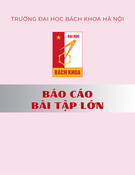
This is the Title of the Book, eMatter Edition
Copyright © 2004 O’Reilly & Associates, Inc. All rights reserved.
529
Chapter 16
CHAPTER 16
HTTP Headers for Optimal
Performance
Header composition is often neglected in the CGI world. Dynamic content is dynamic,
after all, so why would anybody care about HTTP headers? Because pages are gener-
ated dynamically, one might expect that pages without a Last-Modified header are
fine, and that an If-Modified-Since header in the client’s request can be ignored. This
laissez-faire attitude is a disadvantage when you’re trying to create a server that is
entirely driven by dynamic components and the number of hits is significant.
If the number of hits on your server is not significant and is never going to be, then it
is safe to skip this chapter. But if keeping up with the number of requests is impor-
tant, learning what cache-friendliness means and how to cooperate with caches to
increase the performance of the site can provide significant benefits. If Squid or
mod_proxy is used in httpd accelerator mode (as discussed in Chapter 12), it is cru-
cial to learn how best to cooperate with it.
In this chapter, when we refer to a section in the HTTP standard, we are using HTTP
standard 1.1, which is documented in RFC 2616. The HTTP standard describes many
headers. In this chapter, we discuss only the headers most relevant to caching. We
divide them into three sets: date headers, content headers, and the special Vary header.
Date-Related Headers
The various headers related to when a document was created, when it was last modi-
fied, and when it should be considered stale are discussed in the following sections.
Date Header
Section 14.18 of the HTTP standard deals with the circumstances under which we
must or must not send a Date header. For almost everything a normal mod_perl user
does, a Date header needs to be generated. But the mod_perl programmer doesn’t have
to worry about this header, since the Apache server guarantees that it is always sent.
,ch16.24742 Page 529 Thursday, November 18, 2004 12:43 PM

This is the Title of the Book, eMatter Edition
Copyright © 2004 O’Reilly & Associates, Inc. All rights reserved.
530 |Chapter 16: HTTP Headers for Optimal Performance
In http_protocol.c, the Date header is set according to $r->request_time. A mod_perl
script can read, but not change, $r->request_time.
Last-Modified Header
Section 14.29 of the HTTP standard covers the Last-Modified header, which is
mostly used as a weak validator. Here is an excerpt from the HTTP specification:
A validator that does not always change when the resource changes is a "weak
validator."
One can think of a strong validator as one that changes whenever the bits of an
entity changes, while a weak value changes whenever the meaning of an entity changes.
What this means is that we must decide for ourselves when a page has changed
enough to warrant the Last-Modified header being updated. Suppose, for example
that we have a page that contains text with a white background. If we change the
background to light gray then clearly the page has changed, but if the text remains
the same we would consider the semantics (meaning) of the page to be unchanged.
On the other hand, if we changed the text, the semantics may well be changed. For
some pages it is not quite so straightforward to decide whether the semantics have
changed or not. This may be because each page comprises several components, or it
might be because the page itself allows interaction that affects how it appears. In all
cases, we must determine the moment in time when the semantics changed and use
that moment for the Last-Modified header.
Consider for example a page that provides a text-to-GIF renderer that takes as input
a font to use, background and foreground colors, and a string to render. The images
embedded in the resultant page are generated on the fly, but the structure of the page
is constant. Should the page be considered unchanged so long as the underlying
script is unchanged, or should the page be considered to have changed with each
new request?
Actually, a few more things are relevant: the semantics also change a little when we
update one of the fonts that may be used or when we update the ImageMagick or
equivalent image-generating program. All the factors that affect the output should be
considered if we want to get it right.
In the case of a page comprised of several components, we must check when the
semantics of each component last changed. Then we pick the most recent of these
times. Of course, the determination of the moment of change for each component
may be easy or it may be subtle.
mod_perl provides two convenient methods to deal with this header: update_mtime( )
and set_last_modified( ). These methods and several others are unavailable in the
standard mod_perl environment but are silently imported when we use Apache::
File. Refer to the Apache::File manpage for more information.
,ch16.24742 Page 530 Thursday, November 18, 2004 12:43 PM

This is the Title of the Book, eMatter Edition
Copyright © 2004 O’Reilly & Associates, Inc. All rights reserved.
Date-Related Headers |531
The update_mtime( ) function takes Unix’s time(2) (in Perl the equivalent is also the
time( ) function) as its argument and sets Apache’s request structure finfo.st_mtime
to this value. It does so only when the argument is greater than the previously stored
finfo.st_mtime.
The set_last_modified( ) function sets the outgoing Last-Modified header to the
string that corresponds to the stored finfo.st_mtime. When passing a Unix time(2)
to set_last_modified( ), mod_perl calls update_mtime( ) with this argument first.
The following code is an example of setting the Last-Modified header by retrieving
the last-modified time from a Revision Control System (RCS)–style of date tag.
use Apache::File;
use Date::Parse;
$Mtime ||= Date::Parse::str2time(
substr q$Date: 2003/05/09 21:34:23 $, 6);
$r->set_last_modified($Mtime);
Normally we would use the Apache::Util::parsedate function, but since it doesn’t
parse the RCS format, we have used the Date::Parse module instead.
Expires and Cache-Control Headers
Section 14.21 of the HTTP standard deals with the Expires header. The purpose of
the Expires header is to determine a point in time after which the document should
be considered out of date (stale). Don’t confuse this with the very different meaning
of the Last-Modified header. The Expires header is useful to avoid unnecessary vali-
dation from now until the document expires, and it helps the recipients to clean up
their stored documents. Here’s an excerpt from the HTTP standard:
The presence of an Expires field does not imply that the original resource will
change or cease to exist at, before, or after that time.
Think carefully before setting up a time when a resource should be regarded as stale.
Most of the time we can determine an expected lifetime from “now” (that is, the time
of the request). We do not recommend hardcoding the expiration date, because
when we forget that we did it, and the date arrives, we will serve already expired doc-
uments that cannot be cached. If a resource really will never expire, make sure to fol-
low the advice given by the HTTP specification:
To mark a response as "never expires," an origin server sends an Expires date
approximately one year from the time the response is sent. HTTP/1.1 servers SHOULD
NOT send Expires dates more than one year in the future.
For example, to expire a document half a year from now, use the following code:
$r->header_out('Expires',
HTTP::Date::time2str(time + 180*24*60*60));
or:
$r->header_out('Expires',
Apache::Util::ht_time(time + 180*24*60*60));
,ch16.24742 Page 531 Thursday, November 18, 2004 12:43 PM

This is the Title of the Book, eMatter Edition
Copyright © 2004 O’Reilly & Associates, Inc. All rights reserved.
532 |Chapter 16: HTTP Headers for Optimal Performance
The latter method should be faster, but it’s available only under mod_perl.
A very handy alternative to this computation is available in the HTTP/1.1 cache-con-
trol mechanism. Instead of setting the Expires header, we can specify a delta value in
aCache-Control header. For example:
$r->header_out('Cache-Control', "max-age=" . 180*24*60*60);
This is much more processor-economical than the previous example because Perl
computes the value only once, at compile time, and optimizes it into a constant.
As this alternative is available only in HTTP/1.1 and old cache servers may not under-
stand this header, it may be advisable to send both headers. In this case the Cache-
Control header takes precedence, so the Expires header is ignored by HTTP/1.1-com-
pliant clients. Or we could use an if...else clause:
if ($r->protocol =~ /(\d\.\d)/ && $1 >= 1.1) {
$r->header_out('Cache-Control', "max-age=" . 180*24*60*60);
}
else {
$r->header_out('Expires',
HTTP::Date::time2str(time + 180*24*60*60));
}
Again, use the Apache::Util::ht_time( ) alternative instead of HTTP::Date::
time2str( ) if possible.
If the Apache server is restarted regularly (e.g., for log rotation), it might be benefi-
cial to save the Expires header in a global variable to save the runtime computation
overhead.
To avoid caching altogether, call:
$r->no_cache(1);
which sets the headers:
Pragma: no-cache
Cache-control: no-cache
This should work in most browsers.
Don’t set Expires with $r->header_out if you use $r->no_cache, because header_out( )
takes precedence. The problem that remains is that there are broken browsers that
ignore Expires headers.
Content Headers
The following sections describe the HTTP headers that specify the type and length of
the content, and the version of the content being sent. Note that in this section we
often use the term message. This term is used to describe the data that comprises the
HTTP headers along with their associated content; the content is the actual page,
image, file, etc.
,ch16.24742 Page 532 Thursday, November 18, 2004 12:43 PM

This is the Title of the Book, eMatter Edition
Copyright © 2004 O’Reilly & Associates, Inc. All rights reserved.
Content Headers |533
Content-Type Header
Most CGI programmers are familiar with Content-Type. Sections 3.7, 7.2.1, and 14.17
of the HTTP specification cover the details. mod_perl has a content_type( ) method
to deal with this header:
$r->content_type("image/png");
Content-Type should be included in every set of headers, according to the standard,
and Apache will generate one if your code doesn’t. It will be whatever is specified in
the relevant DefaultType configuration directive, or text/plain if none is active.
Content-Length Header
According to section 14.13 of the HTTP specification, the Content-Length header is
the number of octets (8-bit bytes) in the body of a message. If the length can be
determined prior to sending, it can be very useful to include it. The most important
reason is that KeepAlive requests (when the same connection is used to fetch more
than one object from the web server) work only with responses that contain a
Content-Length header. In mod_perl we can write:
$r->header_out('Content-Length', $length);
When using Apache::File, the additional set_content_length( ) method, which is
slightly more efficient than the above, becomes available to the Apache class. In this
case we can write:
$r->set_content_length($length);
The Content-Length header can have a significant impact on caches by invalidating
cache entries, as the following extract from the specification explains:
The response to a HEAD request MAY be cacheable in the sense that the information
contained in the response MAY be used to update a previously cached entity from that
resource. If the new field values indicate that the cached entity differs from the
current entity (as would be indicated by a change in Content-Length, Content-MD5,
ETag or Last-Modified), then the cache MUST treat the cache entry as stale.
It is important not to send an erroneous Content-Length header in a response to
either a GET or a HEAD request.
Entity Tags
An entity tag (ETag) is a validator that can be used instead of, or in addition to, the
Last-Modified header; it is a quoted string that can be used to identify different ver-
sions of a particular resource. An entity tag can be added to the response headers like
this:
$r->header_out("ETag","\"$VERSION\"");
,ch16.24742 Page 533 Thursday, November 18, 2004 12:43 PM










![Đồ án tốt nghiệp: Thiết kế và lập trình website [chuẩn SEO]](https://cdn.tailieu.vn/images/document/thumbnail/2025/20250714/vijiraiya/135x160/954_do-an-tot-nghiep-thiet-ke-va-lap-trinh-website.jpg)








![Hệ thống quản lý cửa hàng bán thức ăn nhanh: Bài tập lớn [chuẩn nhất]](https://cdn.tailieu.vn/images/document/thumbnail/2025/20251112/nguyenhuan6724@gmail.com/135x160/54361762936114.jpg)
![Bộ câu hỏi trắc nghiệm Nhập môn Công nghệ phần mềm [mới nhất]](https://cdn.tailieu.vn/images/document/thumbnail/2025/20251111/nguyenhoangkhang07207@gmail.com/135x160/20831762916734.jpg)





